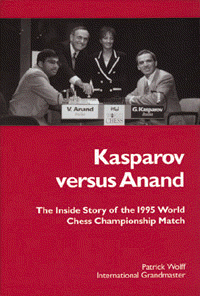
Game 4
Friday, 15 September 1995
Game 4 was rather strange. It had flashes of excellent play intermingled with moments of flaccid, nervous play. And all in just 21 moves. This game clearly indicates that both players were shaken by the turn of events in game 3. Kasparov must have been very upset to have been so close to getting blown off the board just a few moves out of the opening, and Anand was upset with himself to have missed a fairly obvious sacrifice after having played such a superb move to set it up. The reaction by both players was caution and timidity. At several points in this game, each player steered for the draw when he could have played more ambitiously. This was a trend we would see from both players through the first eight games of the match.
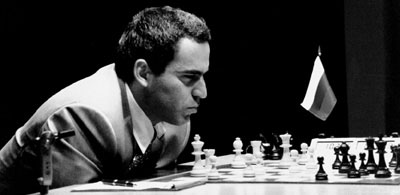
Kasparov ponders his 21st move ...
Kasparov--Anand, New York (m/4) 1995
English Opening A17
1 Nf3!?
We were still expecting 1 e4, figuring that if Kasparov had not shown anything against the Nimzo-Indian, he would try to see what he could achieve on the other side of the board. The way Kasparov played is patient, not trying for any advantage, just setting up a tense position and seeing whether he can outplay Anand with the white pieces.
1 ... Nf6 2 c4 e6 3 Nc3 Bb4 4 g3 0-0 5 Bg2 d5 6 Qb3 c5 7 0-0 Nc6 8 d3 h6
Of course, Black should stop White from playing Bg5, which would put intolerable pressure on the d5 pawn.
9 e3!?
Also possible is 9 a3, when there might follow: 9 ... Bxc3 (9 ... Ba5) 10 Qxc3 d4 (10 ... a5 11 Ne5!? Nxe5 12 Qxe5 b6 13 b3) 11 Qc2 a5 (11 ... e5? 12 b4!) 12 Bf4 (12 e3 e5) 12 ... Nh5!? 13 Ne5 (13 Bd2 e5) 13 ... Nxf4 14 Nxc6 Nxe2+ 15 Qxe2 bxc6 16 Bxc6 Rb8. There isn't any experience with the position after move eight in the game -- at least not in my database of recent games. Perhaps this is one of those times when we must look at the games of the past to relearn what to do.
9 ... Re8!
This is a superb move. Anand told me that his original thought was 9 ... b6, but he realized that although the move looks normal, it doesn't really address the needs of Black's position, to wit: 10 a3! and now:
a) 10 ... Bxc3 11 Qxc3 Bb7 12 b3! is slightly better for White, but less good is 12 b4 cxb4 13 axb4 dxc4 14 dxc4 (14 Qxc4 Rc8 is unclear) 14 ... Ne4 15 Qb3 a5! when Black gets good counterplay against White's overextended queenside pawns.
b) 10 ... dxc4 11 dxc4 (11 Qxc4? Na5 12 Qa2 Bxc3 13 bxc3 Bb7 is slightly better for Black) 11 ... Na5 (11 ... Bxc3 12 Qxc3 Bb7 13 b3! with the idea of 14 Bb2 is pleasantly better for White -- once again, it would be a mistake for White to push the pawn to b4 where it would just give Black counterplay.) 12 Qc2 Bxc3 13 Qxc3 Bb7 (13 ... Qc7 14 Nd2 Bb7 15 b4 Bxg2 16 Kxg2 Nc6 17 Bb2 +/=) 14 b4 Nc6 (14 ... Ne4?? 15 Qc2 wins a piece) 15.Bb2 +/=.
Anand's idea is to eschew ... b6 altogether, instead playing for ... e6-e5 in the center.

10 a3
10 Na4!?
10 ... dxc4
10 ... Bxc3 was also possible, to go for a Modern Benoni setup, i.e., 11 Qxc3 d4 (11 ... dxc4? 12 Qxc4 is just better for White) 12 exd4 (12 Qc2 a5) 12 ... cxd4 13 Qc2 a5, as was suggested by Nick deFirmian during the game. After 14 Nd2 (14 Rb1 e5 15 b4 axb4 16 axb4 e4!? 17 dxe4 d3 is unclear) 14 ... e5 15 Rb1, the game is
very sharp.
Bad, however, is 10 ... Ba5 11 Na4!, as pointed out by the bulletin, which mentions this line as an example: 11 ... Qe7 12 Qc2 b6 13 cxd5 exd5 14 b4!
11 dxc4 Bxc3 12 Qxc3 e5 13 b4 e4 14 Nd2 [1]
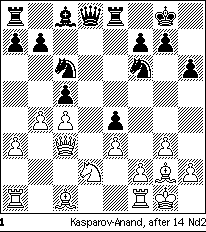
This was the position Anand had envisioned when he played 9 ... Re8. His intuition had told him that Black should stand well, but now he had to find a concrete continuation. In fact he chose a promising idea, but with the wrong follow-up in mind. A less incisive but still quite reasonable way to go was 14 ... Bf5, as suggested by many people including Seirawan, who gave the continuation 15 Nb3 cxb4 16 axb4 Ne5 with a sharp and unclear position.
14 ... Qe7! 15 b5
This must have been Kasparov's intention a few moves earlier, but it was not impossible to play 15 bxc5 Qxc5 16 Bb2. Kasparov's continuation is more ambitious but also more risky.
15 ... Ne5!
There is really no question about this move. If Black were to retreat the knight to d8 or b8, White would have too easy a time after 16 Bb2.
16 Nxe4 [2]
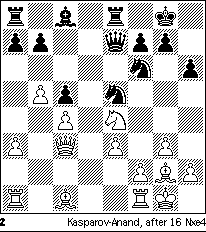
Nor was there a question about this. After 16 Bb2 Bf5 (16 ... Nd3!?), Black has a pleasant advantage at no cost. But now how should Black play?
16 ... Nf3+?
This clever idea is actually a mistake. Black had two other moves:
a) The first is 16 ... Nxe4 17 Bxe4 Nxc4 (the bulletin points out that 17 ... Bh3? is strongly met by 18 Bb2! Bxf1 19 Rxf1, when White has tremendous compensation for his tiny material investment), which is the obvious continuation, and was in fact Anand's first idea several moves earlier when he had first envisioned this position. After 18 Bd5 (18 Qxc4? Qxe4 is good for Black; 19 Qxc5?? is suicide: 19 ... Bh3 20 f3 Qd3 21 Re1 Rac8 22 Qxa7 Qc2 -+) 18 ... Nb6 (18 ... Qe5?? 19 Qxc4 Qxa1 20 Bxf7+) 19 Bb2 Qg5 20 Bb3! (not 20 Bg2 Na4) is unclear, might be promising for White. Still, if Black did not have the stronger line considered in variation b, this would be acceptable, and better than what Anand played.
b) Much stronger is 16 ... Bh3! as I suggested to Ilya Gurevich as we were watching the game together (later I learned that Pal Benko had also suggested it around the same time). How should White reply?
b1) 17 Bxh3 Nf3+! (Anand told me afterward that he had seen 16 ... Bh3, but that he had not seen this move, which Kasparov mentioned to him just after they agreed to the draw. If Black does not have this move, he would have to play 17 ... Nxe4 18 Qc2 Nd6 [18 ... Nf3+ 19 Kg2! makes a critical difference for White's defense -- the king does not have to go to h1, so Black cannot coordinate the knights in time, i.e., 19 ... Nfg5 20 Bf5; 19 ... Neg5 20 Bg4; 19 ... Rad8 20 Kxf3 Qf6+ 21 Kg2 Qxa1 22 Bb2 Qa2 23 Ra1] 19 Bg2, and the game should favor the two bishops) 18 Kh1 (now 18 Kg2 is strongly met by 18 ... Qxe4! 19 Kh1 Ng4!) 18 ... Nxe4 19 Qc2? (19 Qb2 is a better move, but Black stands well after 19 ... Rad8 [19 ... Qg5 20 Bg2 Qh5 is just unclear] and White is tied up badly, e.g., 20 Bg2 Nfd2!) 19 ... Qe5 20 Bg2 (20 Bb2 Qh5 21 Kg2 Neg5 22 Qf5 Re4! and 23 ... Rh4! is coming, e.g., 23 Rfd1 Rh4! 24 g4 Rxh3! 25 gxh5 Nh4+) 20 ... Qxa1 21 Bb2 (21 Bxf3 Qe5 22 Bb2 Qf5 23 Kg2 Rad8 is clearly better for Black) and while it may look like Black's queen is trapped, take a look at 21 ... Ne1!! 22 Qe2 Qa2 23 Rxe1 Rad8 24 Ra1 Qb3.
b2) 17 Nxf6+ Qxf6 and now:
b21) 18 Bxh3?? Nf3+ wins the queen;
b22) 18 e4 Rad8 (18 ... Bxg2 19 Kxg2 Qe6 =/+ isn't bad either) 19 Bb2 (19 f4 Bxg2 20 Kxg2 Nxc4! is very good for Black, because after 21 Qxf6 gxf6, Black's shattered kingside pawns are not as important as White's weak e-pawn and Black's strong queenside, as well as the strong domination of the White bishop by the powerful Nc4) 19 ... Bxg2 20 Kxg2 Rd4, and Black has a large advantage;
b23) 18 Bb2 Bxg2 (18 ... Nf3+? 19 Bxf3 Bxf1 [19 ... Qxf3?? 20 Qxg7 mate] 20 Qxf6 gxf6 21 Bxb7 Rab8 22 Bc6 +/-) 19 Kxg2 Qf3+ 20 Kg1, and now I think the best move is 20 ... h5! threatening a quick 21 ... h4, making White's king position tender. Less accurate is 20 ... Rad8 21 Qc2 h5 22 Bxe5!, when 22 ... Rxe5 probably gives Black about enough for the pawn, but not more, and 22 ... h4? 23 Rfd1! h3 24 Kf1! suddenly gives White a winning position.
b3) 17 Bb2 Bxg2 (17 ... Nxe4? 18 Bxe4 Bxf1 19 Rxf1 with the idea of 20 f4 gives White good compensation in his powerful bishops and extra center pawn) 18 Nxf6+ Qxf6 19 Kxg2 Qf3+ transposes to b23.
b4) 17 Bh1 is a slightly wacky possibility. White gets a certain amount of compensation for the exchange: 17 ... Nxe4 18 Bxe4 Bxf1 19 Kxf1 Nxc4 20 Bd5! Ne5 (20 ... Qe5? 21 Qxc4 Qxa1 22 Bxf7+ Kh8 23 Bxe8 Rxe8 24 Qxc5 is not good, but 20 ... Nd6!? 21 Bb2 Qg5 22 Qxc5 Rad8 is interesting) 21 Bb2 Rad8 22 e4 and White threatens 23 f4, so Black should either play 23 ... Qf6 or 23 ... Rxd5 24 exd5 f6 25 Re1 Qf8. My feeling is that Black should be able to prove an advantage, but the position is murky.
b5) 17 Nd2 Bxg2 18 Kxg2 Rad8 is unclear. Black has fairly good compensation for the pawn because of his lead in development and White's weaknesses on both sides of the board. Still, a pawn is a pawn, so the most I will say is "unclear." One cute line is 19 Bb2 b6! 20 Qxe5?? Qb7+!
Anand's idea was to liquidate the position and reach a positional draw. White would have an extra pawn but also a weak c4 pawn and opposite colored bishops, thereby giving Black enough counterplay for equality. There are two flaws with this idea. First, White has a simple tactical trick that allows him not to trade his light-squared bishop for the e4-knight, and second, even when he does do so, the position is not so dead-drawn as both players thought.

17 Bxf3 Nxe4 18 Bxe4?
Several days later, we were chatting about something else, and somehow the subject turned to this game. Anand then admitted rather sheepishly that he had realized during the interim that this move was not forced, as he and Kasparov and virtually all the other grandmasters had thought, because after 18 Qc2 Bf5, White can play simply 19 Bb2!, when Black cannot play 19 ... Nxg3?? because of 20 Qc3 +-. But that means that White gains a crucial tempo that allows him to consolidate his extra pawn: 19 ... Qe6 (to defend the Bf5) 20 Qe2 Rad8 21 Rad1, and White is up a solid pawn, although the weakness of his queenside and Black's well-centralized pieces do still give Black some chances to drum up play.
18 ... Qxe4 19 f3 Qe7 20 e4 Be6 [3]
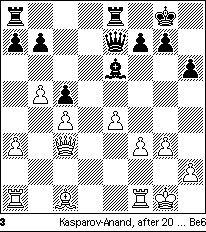
At this point, I was nervous that Anand was going to have to defend a worse position for a long time. All the other grandmasters were anticipating a long game to come. Moments later those of us in the press room saw on the monitor that the players were shaking hands. Draw? What had happened? What had happened is that Kasparov had played his next move and offered a draw, which Anand had immediately accepted.
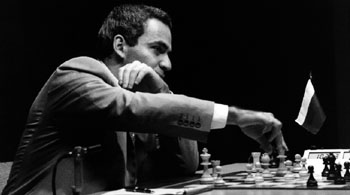
Kasparov makes his move and offers a draw ...
21 Be3 1/2--1/2
After this move, it is true that White has no advantage, because Black plays ... Rad8, ... b6, ... f6, ... Qf7, and Black has good counterplay against White's c-pawn. But the text move is not the best. Better is 21 Bb2! f6 22 e5! f5 (22 ... fxe5 23 Rae1 opens up lines for White, and if 23 ... Qf7 24 Rxe5 Bxc4?, then 25 Rf5! wins for White) 23 Rfd1 Qf7 (23 ... Rad8 24 Rd6!) 24 Rac1. Black is certainly not dead, but White has every reason to continue.
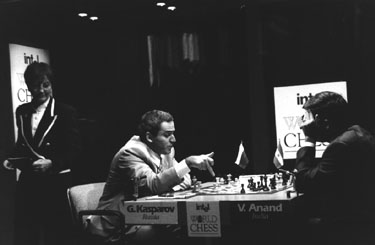
... and the players discuss the game while Arbiter Carol Jarecki looks on.
It was a strange case of double-blindness. Both players seemed almost hypnotized by the idea that the position was leading inexorably to a draw, when in fact there were many subtle twists and turns possible at every move.
After 4 games: Kasparov 2, Anand 2
This page last modified on
28 April 2018.
Copyright (c) 1995-2018 Christopher F. Chabris. All rights
reserved.








